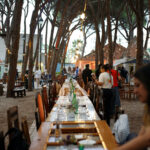
Chefs on Fire. In this festival, leftover food is transformed into energy
Here comes another edition of Chefs on Fire, one of the most important gastronomic festivals in the country. In addition to the sustainability actions that
We didn't find any happenings mapped to your criteria.
Try the traditional search to find articles not yet mapped with RUA.
We didn't find any happenings mapped to your criteria.
Try the traditional search to find articles not yet mapped with RUA.
We didn't find any happenings mapped to your criteria.
Try the traditional search to find articles not yet mapped with RUA.
We didn't find any happenings mapped to your criteria.
Try the traditional search to find articles not yet mapped with RUA.
Researchers at Chalmers University of Technology have created a lightweight structural battery that could be the answer to electrifying air travel and making cars more efficient.
After years of study, researchers at Chalmers University of Technology in Sweden have managed to create a strong, resistant and lightweight structural battery from carbon fiber that can be integrated into a wide variety of applications.
Structural batteries can store energy but also support loads, which means that their material can become part of a product’s construction material. In other words, if a car, airplane, ship or computer is built from a material that functions both as a battery and as a load-bearing structure, weight and energy consumption are radically reduced.
Presented as the “world’s strongest battery”, this creation could make cell phones as “thin as a credit card”, halve the weight of laptops and increase the range of an electric car by up to 70% on a single charge.
“We have succeeded in creating a battery made of carbon fiber composite that is as rigid as aluminum and energy-dense enough to be used commercially. Like a human skeleton, the battery has several functions at the same time,” says Richa Chaudhary, a scientist at Chalmers and one of the authors of the article recently published in the journal Advanced Materials.
The team at Chalmers University has been investigating the possibility of structural batteries for several years. In 2018, the team of researchers published their first results on rigid, high-strength carbon fibers capable of storing electrical energy chemically. Since then, the concept has continued to evolve, increasing both rigidity and energy density.
In 2021, they made their first breakthrough with a battery that had an energy density of 24 watt-hours per kilogram – around 20% of the capacity of an equivalent lithium-ion battery.
The latest version reaches 30 watt-hours per kilogram and, although the value is still lower than current batteries, it has some advantages.
“In terms of multifunctional properties, the new battery is twice as good as its predecessor – and, in fact, the best ever made in the world,” says Professor Leif Asp, lead researcher at Chalmers University of Technology.
However, one of the criticisms levelled at the new technology is that they are difficult to replace, since they are an integral part of the construction.
From the outset, the aim of the research has been to achieve a performance that would allow the technology to be commercialized. In parallel with the progress of the research, the link to the market has now been strengthened through the newly created company Chalmers Venture Sinonus AB, based in Borås, Sweden.
Before batteries go from small-scale laboratory manufacture to large-scale production for technological products or vehicles, there is still a lot of engineering work to be done.
“Major investments will be needed to meet the demanding energy needs of the transport industry, but this is also where technology can make the biggest difference”, says Leif Asp, who has noticed great interest from the automotive and aerospace industries.


Here comes another edition of Chefs on Fire, one of the most important gastronomic festivals in the country. In addition to the sustainability actions that

From July 31st to August 4th there will be another edition of the Tradidanças festival, the one that gets everyone of all ages dancing for

Greenpeace opens office in Portugal and brings the icebreaker Artic Sunrise. The organization’s focus will be on fighting fires and protecting biodiversity, especially the oceans.

This article addresses an action that promotes inclusive and sustainable industrialization and fosters innovation. SDG 9 also supports greater adoption of renewable technologies.
 To discover businesses that are actively working to contribute to this Sustainable Development Goal, click here.
To discover businesses that are actively working to contribute to this Sustainable Development Goal, click here. To read news, interviews or tips related to this Goal, click here.
To read news, interviews or tips related to this Goal, click here.Esta publicação também está disponível em:
![]() Português (Portuguese (Portugal))
Português (Portuguese (Portugal))

